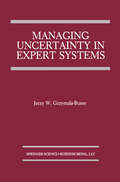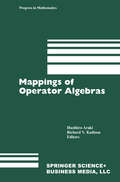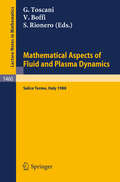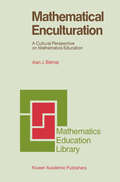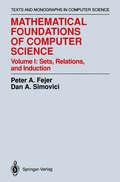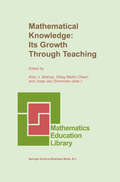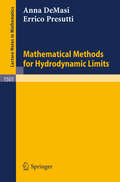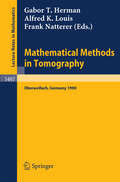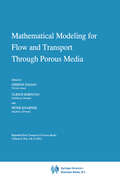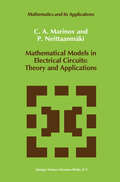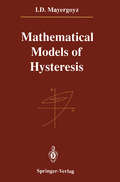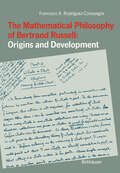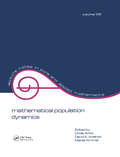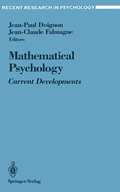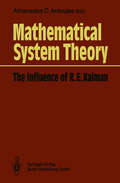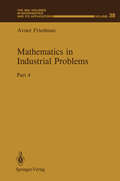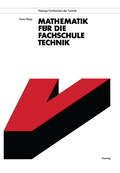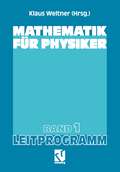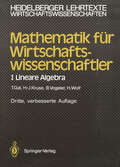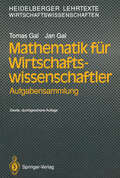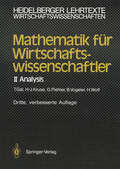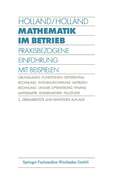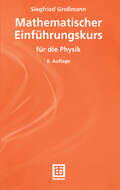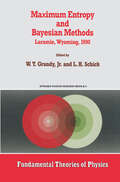- Table View
- List View
Managing Uncertainty in Expert Systems (The Springer International Series in Engineering and Computer Science #143)
by Jerzy W. Grzymala-Busse3. Textbook for a course in expert systems,if an emphasis is placed on Chapters 1 to 3 and on a selection of material from Chapters 4 to 7. There is also the option of using an additional commercially available sheU for a programming project. In assigning a programming project, the instructor may use any part of a great variety of books covering many subjects, such as car repair. Instructions for mostofthe "weekend mechanic" books are close stylisticaUy to expert system rules. Contents Chapter 1 gives an introduction to the subject matter; it briefly presents basic concepts, history, and some perspectives ofexpert systems. Then itpresents the architecture of an expert system and explains the stages of building an expert system. The concept of uncertainty in expert systems and the necessity of deal ing with the phenomenon are then presented. The chapter ends with the descrip tion of taxonomy ofexpert systems. Chapter 2 focuses on knowledge representation. Four basic ways to repre sent knowledge in expert systems are presented: first-order logic, production sys tems, semantic nets, and frames. Chapter 3 contains material about knowledge acquisition. Among machine learning techniques, a methodofrule learning from examples is explained in de tail. Then problems ofrule-base verification are discussed. In particular, both consistency and completeness oftherule base are presented.
Mappings of Operator Algebras: Proceedings of the Japan—U.S. Joint Seminar,University of Pennsylvania, 1988 (Progress in Mathematics #84)
by H. Araki R.V. KadisonThis volume consists of articles contributed by participants at the fourth Ja pan-U.S. Joint Seminar on Operator Algebras. The seminar took place at the University of Pennsylvania from May 23 through May 27, 1988 under the auspices of the Mathematics Department. It was sponsored and supported by the Japan Society for the Promotion of Science and the National Science Foundation (USA). This sponsorship and support is acknowledged with gratitude. The seminar was devoted to discussions and lectures on results and prob lems concerning mappings of operator algebras (C*-and von Neumann alge bras). Among the articles contained in these proceedings, there are papers dealing with actions of groups on C* algebras, completely bounded mappings, index and subfactor theory, and derivations of operator algebras. The seminar was held in honor of the sixtieth birthday of Sh6ichir6 Sakai, one of the great leaders of Functional Analysis for many decades. This vol ume is dedicated to Professor Sakai, on the occasion of that birthday, with the respect and admiration of all the contributors and the participants at the seminar. H. Araki Kyoto, Japan R. Kadison Philadelphia, Pennsylvania, USA Contents Preface.... ..... ....... ........... ...... ......... ................ ...... ............... ... vii On Convex Combinations of Unitary Operators in C*-Algebras UFFE HAAGERUP ......................................................................... .
Mathematical Aspects of Fluid and Plasma Dynamics: Proceedings of an International Workshop held in Salice Terme, Italy, 26-30 September 1988 (Lecture Notes in Mathematics #1460)
by Giuseppe Toscani Vinicio Boffi Salvatore RioneroMathematical Enculturation: A Cultural Perspective on Mathematics Education (Mathematics Education Library #6)
by Alan BishopMathematics is in the unenviable position of being simultaneously one of the most important school subjects for today's children to study and one of the least well understood. Its reputation is awe-inspiring. Everybody knows how important it is and everybody knows that they have to study it. But few people feel comfortable with it; so much so that it is socially quite acceptable in many countries to confess ignorance about it, to brag about one's incompe tence at doing it, and even to claim that one is mathophobic! So are teachers around the world being apparently legal sadists by inflicting mental pain on their charges? Or is it that their pupils are all masochists, enjoying the thrill of self-inflicted mental torture? More seriously, do we really know what the reasons are for the mathematical activity which goes on in schools? Do we really have confidence in our criteria for judging what's important and what isn't? Do we really know what we should be doing? These basic questions become even more important when considered in the context of two growing problem areas. The first is a concern felt in many countries about the direction which mathematics education should take in the face of the increasing presence of computers and calculator-related technol ogy in society.
Mathematical Foundations of Computer Science: Sets, Relations, and Induction (Monographs in Computer Science)
by Peter A. Fejer Dan A. SimoviciMathematical Foundations of Computer Science, Volume I is the first of two volumes presenting topics from mathematics (mostly discrete mathematics) which have proven relevant and useful to computer science. This volume treats basic topics, mostly of a set-theoretical nature (sets, functions and relations, partially ordered sets, induction, enumerability, and diagonalization) and illustrates the usefulness of mathematical ideas by presenting applications to computer science. Readers will find useful applications in algorithms, databases, semantics of programming languages, formal languages, theory of computation, and program verification. The material is treated in a straightforward, systematic, and rigorous manner. The volume is organized by mathematical area, making the material easily accessible to the upper-undergraduate students in mathematics as well as in computer science and each chapter contains a large number of exercises. The volume can be used as a textbook, but it will also be useful to researchers and professionals who want a thorough presentation of the mathematical tools they need in a single source. In addition, the book can be used effectively as supplementary reading material in computer science courses, particularly those courses which involve the semantics of programming languages, formal languages and automata, and logic programming.
Mathematical Knowledge: Its Growth Through Teaching (Mathematics Education Library #10)
by Alan Bishop Stieg Mellin-Olsen Joop Van DormolenIn the first BACOMET volume different perspectives on issues concerning teacher education in mathematics were presented (B. Christiansen, A. G. Howson and M. Otte, Perspectives on Mathematics Education, Reidel, Dordrecht, 1986). Underlying all of them was the fundamental problem area of the relationships between mathematical knowledge and the teaching and learning processes. The subsequent project BACOMET 2, whose outcomes are presented in this book, continued this work, especially by focusing on the genesis of mathematical knowledge in the classroom. The book developed over the period 1985-9 through several meetings, much discussion and considerable writing and redrafting. Our major concern was to try to analyse what we considered to be the most significant aspects of the relationships in order to enable mathematics educators to be better able to handle the kinds of complex issues facing all mathematics educators as we approach the end of the twentieth century. With access to mathematics education widening all the time, with a multi tude of new materials and resources being available each year, with complex cultural and social interactions creating a fluctuating context of education, with all manner of technology becoming more and more significant, and with both informal education (through media of different kinds) and non formal education (courses of training etc. ) growing apace, the nature of formal mathematical education is increasingly needing analysis.
Mathematical Methods for Hydrodynamic Limits (Lecture Notes in Mathematics #1501)
by Anna DeMasi Errico PresuttiEntropy inequalities, correlation functions, couplings between stochastic processes are powerful techniques which have been extensively used to give arigorous foundation to the theory of complex, many component systems and to its many applications in a variety of fields as physics, biology, population dynamics, economics, ... The purpose of the book is to make theseand other mathematical methods accessible to readers with a limited background in probability and physics by examining in detail a few models where the techniques emerge clearly, while extra difficulties arekept to a minimum. Lanford's method and its extension to the hierarchy of equations for the truncated correlation functions, the v-functions, are presented and applied to prove the validity of macroscopic equations forstochastic particle systems which are perturbations of the independent and of the symmetric simple exclusion processes. Entropy inequalities are discussed in the frame of the Guo-Papanicolaou-Varadhan technique and of theKipnis-Olla-Varadhan super exponential estimates, with reference to zero-range models. Discrete velocity Boltzmann equations, reaction diffusion equations and non linear parabolic equations are considered, as limits of particles models. Phase separation phenomena are discussed in the context of Glauber+Kawasaki evolutions and reaction diffusion equations. Although the emphasis is onthe mathematical aspects, the physical motivations are explained through theanalysis of the single models, without attempting, however to survey the entire subject of hydrodynamical limits.
Mathematical Methods in Tomography: Proceedings of a Conference held in Oberwolfach, Germany, 5-11 June, 1990 (Lecture Notes in Mathematics #1497)
by Gabor T. Herman Alfred K. Louis Frank NattererThe conference was devoted to the discussion of present and future techniques in medical imaging, including 3D x-ray CT, ultrasound and diffraction tomography, and biomagnetic ima- ging. The mathematical models, their theoretical aspects and the development of algorithms were treated. The proceedings contains surveys on reconstruction in inverse obstacle scat- tering, inversion in 3D, and constrained least squares pro- blems.Research papers include besides the mentioned imaging techniques presentations on image reconstruction in Hilbert spaces, singular value decompositions, 3D cone beam recon- struction, diffuse tomography, regularization of ill-posed problems, evaluation reconstruction algorithms and applica- tions in non-medical fields. Contents: Theoretical Aspects: J.Boman: Helgason' s support theorem for Radon transforms-a newproof and a generalization -P.Maass: Singular value de- compositions for Radon transforms- W.R.Madych: Image recon- struction in Hilbert space -R.G.Mukhometov: A problem of in- tegral geometry for a family of rays with multiple reflec- tions -V.P.Palamodov: Inversion formulas for the three-di- mensional ray transform - Medical Imaging Techniques: V.Friedrich: Backscattered Photons - are they useful for a surface - near tomography - P.Grangeat: Mathematical frame- work of cone beam 3D reconstruction via the first derivative of the Radon transform -P.Grassin,B.Duchene,W.Tabbara: Dif- fraction tomography: some applications and extension to 3D ultrasound imaging -F.A.Gr}nbaum: Diffuse tomography: a re- fined model -R.Kress,A.Zinn: Three dimensional reconstruc- tions in inverse obstacle scattering -A.K.Louis: Mathemati- cal questions of a biomagnetic imaging problem - Inverse Problems and Optimization: Y.Censor: On variable block algebraic reconstruction techniques -P.P.Eggermont: On Volterra-Lotka differential equations and multiplicative algorithms for monotone complementary problems
Mathematical Modeling for Flow and Transport Through Porous Media
by Gedeon Dagan Ulrich Hornung Peter KnabnerThe main aim of this paper is to present some new and general results, ap plicable to the the equations of two phase flow, as formulated in geothermal reservoir engineering. Two phase regions are important in many geothermal reservoirs, especially at depths of order several hundred metres, where ris ing, essentially isothermal single phase liquid first begins to boil. The fluid then continues to rise, with its temperature and pressure closely following the saturation (boiling) curve appropriate to the fluid composition. Perhaps the two most interesting theoretical aspects of the (idealised) two phase flow equations in geothermal reservoir engineering are that firstly, only one component (water) is involved; and secondly, that the densities of the two phases are so different. This has led to the approximation of ignoring capillary pressure. The main aim of this paper is to analyse some of the consequences of this assumption, especially in relation to saturation changes within a uniform porous medium. A general analytic treatment of three dimensional flow is considered. Pre viously, three dimensional modelling in geothermal reservoirs have relied on numerical simulators. In contrast, most of the past analytic work has been restricted to one dimensional examples.
Mathematical Models in Electrical Circuits: Theory and Applications (Mathematics and Its Applications #66)
by C. A. Marinov Pekka NeittaanmäkiMathematical Models of Hysteresis
by I.D. MayergoyzThe purpose of this book is to describe in sufficient detail the mathematical models of hysteresis nonlinearities with "nonlocal memories. " The distinct feature of these nonlinearities is that their future states depend on past histories of input variations. It turns out that memories of hysteresis nonlinearities are quite selective. Indeed, experiments show that only some past input extrema (not the entire input variations) leave their marks upon future states of hysteresis nonlinearities. Thus, special mathematical tools are needed to describe nonlocal selective memories of hysteresis nonlinearities. The origin of such tools can be traced back to the landmark paper of Preisach. The book is primarily concerned with Preisach-type models of hysteresis. All these models have a common generic feature; they are constructed as superposi tions of simplest hysteresis nonlinearities-rectangular loops. The discussion is by and large centered around the following topics: various generalizations and extensions of the classical Preisach model (with special emphasis on vector generalizations), finding of necessary and sufficient conditions for the represen tation of actual hysteresis nonlinearities by various Preisach-type models, solution of identification problems for these models, and numerical implementa tion and experimental testing of Preisach-type models. Although the study of Preisach-type models constitutes the main subject of the book, some effort is also made to establish some interesting connections between these models and such topics as the critical state model for superconducting hysteresis, the classi cal Stoner-Wohlfarth model for vector magnetic hysteresis, thermal activation type models for viscosity, magnetostrictive hysteresis and neural networks.
The Mathematical Philosophy of Bertrand Russell: Origins and Development
by Francisco A. Rodríguez-Consuegraby Ivor Grattan-Guinness Until twenty years ago the outline history of logicism was well known. Frege had had the important ideas, until he was eclipsed by Wittgenstein. Russell was important in publicising the former and tutoring the latter, and also for working with Moore in the conversion of British philosophy from neo-Hegelianism to the new analytic tradition in the 1900s, but his own work on logic and especially logicism was very muddled. Around that time Russell, who was still alive, sold his manuscripts to McMaster University in Canada, and interest in his achievements in logic began to develop, especially after his death in 1970. Scholars found thousands of folios of unpublished holograph awaiting their attention, and also hundreds of pertinent letters (both in the Russell Archives and elsewhere in certain recipients' collections). Various facets of his work came to light for the first time, and others -which could have been gleaned from carefully reading of the published sources- gained new publicity from the evidence revealed in manuscripts. Even the technical passage work, which constitutes the unread majority of the Principia mathematica (1910-13) of Russell and Whitehead, began to receive a little respectful scrutiny. It turned out that Russell had done several pioneering things. While indeed often incoherent in reference and content, they comprised major forays into the new mathematical logic, of which he turned out to be a major founder: some are even of interest to modem studies.
mathematical population dynamics: Proceedings of the Second International Conference
by Ovide ArinoThis book is an outcome of the Second International Conference on Mathematical Population Dynamics. It is intended for mathematicians, statisticians, biologists, and medical researchers who are interested in recent advances in analyzing changes in populations of genes, cells, and tumors.
mathematical population dynamics: Proceedings of the Second International Conference
by Ovide ArinoThis book is an outcome of the Second International Conference on Mathematical Population Dynamics. It is intended for mathematicians, statisticians, biologists, and medical researchers who are interested in recent advances in analyzing changes in populations of genes, cells, and tumors.
Mathematical Psychology: Current Developments (Recent Research in Psychology)
by Jean-Paul Doignon Jean-Claude FalmagneSometime in the late sixties, one of the editors of this volume realized that the mathematica psychologists in Europe-an odd lot mostly concentrated in Germany, the Netherlands, France, England and Belgium-were suffering from an acute sense of isolation. The papers that they presented at meetings of their national or regional societies had to be 'sanitized' to the point of misrepresentation. They were misunderstood. The mood was grim, depression was lurking. He decided that urgent action was required: a European gathering of mathematical psychologists was called in April 1971. Not being foolhardy, however, he took the precaution of choosing Paris as the meeting place. Around thirty mathematical psychologists received an invitation. They all came, justifying at least Paris's reputation. The meeting took place at the 'Maison des Belges' of the Cite Universitaire, Boulevard Jourdan, in front of the Parc Montsouris. As far as everyone remembers, the meeting was a full success. A happy birth had taken place. This editor then irresponsibly accepted a position in a university in the US, leaving an infant to the whims of the passers-by. Fortunately, a godfather came along. The next meeting took place in Nijmegen, in November 1971, under the loving care of Eddy Roskam. A tradition was established. The third meeting was in Oxford (1972); then in Marseilles (1973), Regensburg (1974), Stirling (1975), Stockholm (1976) . . . The infant became a toddler, then a vigorous child. This annual meeting is now an important event in the field.
Mathematical System Theory: The Influence of R. E. Kalman
by Athanasios C. AntoulasOver the past three decades R.E. Kalman has been one of the most influential personalities in system and control theory. His ideas have been instrumental in a variety of areas. This is a Festschrift honoring his 60th birthday. It contains contributions from leading researchers in the field giving an account of the profound influence of his ideas in a number of areas of active research in system and control theory. For example, since their introduction by Kalman in the early 60's, the concepts of controllability and observability of dynamical systems with inputs, have been the corner stone of the great majority of investigations in the field.
Mathematics in Industrial Problems: Part 4 (The IMA Volumes in Mathematics and its Applications #38)
by Avner FriedmanThis is the fourth volume in the series "Mathematics in Industrial Prob lems." The motivation for these volumes is to foster interaction between Industry and Mathematics at the "grass roots"; that is, at the level of spe cific problems. These problems come from Industry: they arise from models developed by the industrial scientists in ventures directed at the manufac ture of new or improved products. At the same time, these problems have the potential for mathematical challenge and novelty. To identify such problems, I have visited industries and had discussions with their scientists. Some of the scientists have subsequently presented their problems in the IMA Seminar on Industrial Problems. The book is based on questions raised in the seminar and subsequent discussions. Each chapter is devoted to one of the talks and is self-contained. The chap ters usually provide references to the mathematical literature and a list of open problems which are of interest to the industrial scientists. For some problems partial solution is indicated briefly. The last chapter of the book contains a short description of solutions to some of the problems raised in the third volume, as well as references to papers in which such solutions have been published.
Mathematik für Wirtschaftswissenschaftler: I Lineare Algebra (Heidelberger Lehrtexte Wirtschaftswissenschaften)
by Tomas Gal Hermann-Josef Kruse Bernhard Vogeler Hartmut WolfDas vorliegende Buch über Mathematik für Wirtschaftswissenschaftler basiert auf langjährigen Erfahrungen mit dem gleichnamigen Kurs der Fernuniversität Hagen. Die Themenauswahl ist so getroffen, daß sie für die Wirtschafts-, Sozial- und Ingenieurwissenschaften die notwendigen Kenntnisse liefert. Behandelt werden in den einzelnen Kapiteln des Buches die Themen Vektoren, Geometrie im Rn, Matrizen, lineare Gleichungs- und Ungleichungssysteme. Jedes Kapitel ist grundsätzlich in zwei Teile unterteilt, im ersten Teil werden die angesprochenen Themenkreise durch motivierende Beispiele eingeführt, im zweiten Teil mathematisch behandelt. Die Darstellung der Inhalte richtet sich insbesondere an die Zielgruppe der Selbststudierenden. Das bedeutet, daß jeder, der die Lineare Algebra als Grundlage für ein weiteres Studium braucht, durch dieses Buch ein Werk in die Hand bekommt, das es ihm ermöglicht, ohne fremde Hilfe, ohne Vorlesungen oder Vorträge zu besuchen, im Selbststudium die notwendigen Kenntnisse zu erwerben. Die didaktischen Erfahrungen, die an der Fernuniversität in jahrelanger Arbeit gesammelt wurden, werden in diesem Buch einen breiten Leserkreis zugänglich gemacht.
Mathematik für Wirtschaftswissenschaftler: Aufgabensammlung (Heidelberger Lehrtexte Wirtschaftswissenschaften)
by Tomas Gal Jan GalDas vorliegende Buch ist als Begleittext zu dem Lehrbuch Mathematik für Wirtschaftswissenschaftler gedacht, kann aber auch unabhängig davon benutzt werden. Es beinhaltet Aufgaben zum selbständigen Durcharbeiten zu allen Themen der Wirtschaftsmathematik, wobei zu einzelnen schwierigen Aufgaben Anleitungen vorhanden sind und am Ende eine ausführliche Lösung mit Lösungsweg angegeben ist. Für den Leser bringt die Durcharbeitung dieses Buches den Vorteil, daß er die Materie der Wirtschaftsmathematik nicht nur besser versteht, sondern auch viel besser behalten kann, so daß es ihm später leichter fällt, die Mathematik bei der Lösung praktischer Probleme zu nutzen.
Mathematik für Wirtschaftswissenschaftler: II Analysis (Heidelberger Lehrtexte Wirtschaftswissenschaften)
by Tomas Gal Hermann-Josef Kruse Gabriele Piehler Bernhard Vogeler Hartmut WolfDas vorliegende Buch über Mathematik für Wirtschaftswissenschaftler basiert auf langjährigen Erfahrungen mit dem gleichnamigen Kurs der Fernuniversität Hagen. Die Themenauswahl ist so getroffen, daß sie für die Wirtschafts-, Sozial- und Ingenieurwissenschaften die notwendigen Kenntnisse liefert. Behandelt werden Funktionen einer und mehrerer Variablen, die Differential- und Integralrechnung. Jedes Kapitel ist grundsätzlich in zwei Teile unterteilt, im ersten Teil werden die angesprochenen Themenkreise durch motivierende Beispiele eingeführt, im zweiten Teil mathematisch behandelt. Die Darstellung der Inhalte richtet sich insbesondere an die Zielgruppe der Selbststudierenden. Das bedeutet, daß jeder, der die Analysis als Grundlage für ein weiteres Studium braucht, durch dieses Buch ein Werk in die Hand bekommt, das es ihm ermöglicht, ohne fremde Hilfe, ohne Vorlesungen oder Vorträge zu besuchen, im Selbststudium die notwendigen Kenntnisse zu erwerben. Die didaktischen Erfahrungen, die an der Fernuniversität in jahrelanger Arbeit gesammelt wurden, werden in diesem Buch einem breiten Leserkreis zugänglich gemacht.
Mathematischer Einführungskurs für die Physik (Teubner Studienbücher Physik)
by Siegfried GroßmannStudierende, die ein Physikstudium aufnehmen, brauchen zu Beginn vor allem eines: mathematische Grundkenntnisse. Da es sich hierbei zunächst um einen relativ beschränkten und charakteristischen Ausschnitt aus der Mathematik handelt, werden die benötigten Kompetenzen vor allem im Rahmen von Tutorien oder Arbeitsgruppen vermittelt. Dieser Einführungskurs soll Studierenden im ersten Semester helfen, die Inhalte dieser Veranstaltungen zu vertiefen und möglichst rechtzeitig die Fähigkeiten zu erwerben, die ein erfolgreiches Physikstudium garantieren.
Maximum Entropy and Bayesian Methods: Laramie, Wyoming, 1990 (Fundamental Theories of Physics #43)
by W. T. Grandy Jr. L. H. SchickThe 10th International Workshop on Maximum Entropy and Bayesian Methods, MaxEnt 90, was held in Laramie, Wyoming from 30 July to 3 August 1990. This volume contains the scientific presentations given at that meeting. This series of workshops originated in Laramie in 1981, where the first three of what were to become annual workshops were held. The fourth meeting was held in Calgary. the fifth in Laramie, the sixth and seventh in Seattle, the eighth in Cambridge, England, and the ninth at Hanover, New Hampshire. It is most appropriate that the tenth workshop, occurring in the centennial year of Wyoming's statehood, was once again held in Laramie. The original purpose of these workshops was twofold. The first was to bring together workers from diverse fields of scientific research who individually had been using either some form of the maximum entropy method for treating ill-posed problems or the more general Bayesian analysis, but who, because of the narrow focus that intra-disciplinary work tends to impose upon most of us, might be unaware of progress being made by others using these same techniques in other areas. The second was to introduce to those who were somewhat aware of maximum entropy and Bayesian analysis and wanted to learn more, the foundations, the gestalt, and the power of these analyses. To further the first of these ends, presenters at these workshops have included workers from area. s as varied as astronomy, economics, environmenta.
